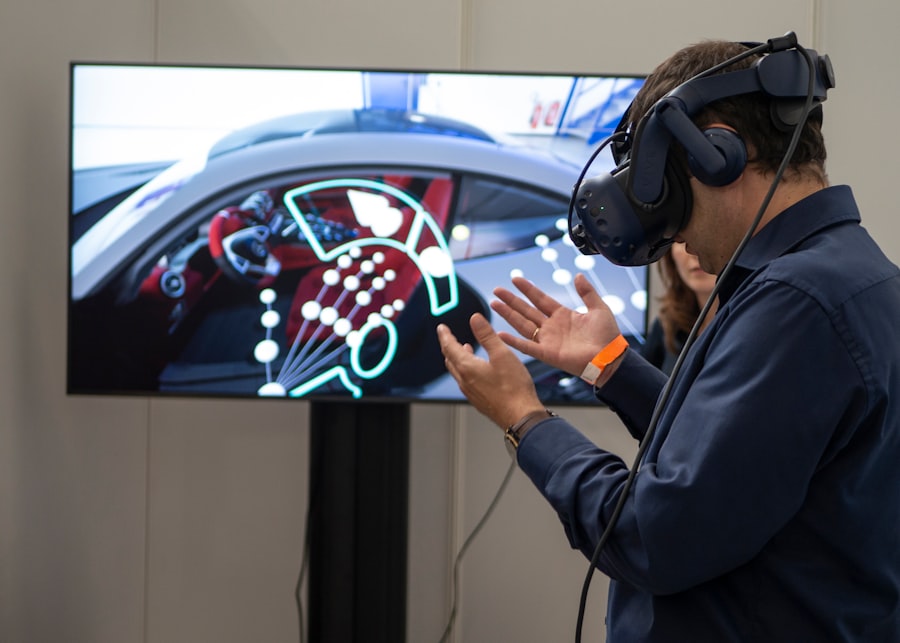Download links
How to install Exploring the Virtual Life: A New Frontier APK?
1. Tap the downloaded Exploring the Virtual Life: A New Frontier APK file.
2. Touch install.
3. Follow the steps on the screen.
Description
The evolution of virtual reality (VR) technology has been nothing short of remarkable, transforming from a niche concept into a mainstream phenomenon. The roots of VR can be traced back to the 1960s with the invention of the Sensorama, a multi-sensory machine that provided users with an immersive experience through sight, sound, and even smell. However, it wasn’t until the 1990s that VR began to capture the public’s imagination, thanks in part to advancements in computer graphics and the introduction of head-mounted displays.
Companies like Sega and Nintendo experimented with VR gaming, but the technology was still in its infancy, plagued by high costs and limited capabilities. Fast forward to the 21st century, and VR has undergone a renaissance fueled by significant technological advancements. The introduction of affordable headsets such as the Oculus Rift, HTC Vive, and PlayStation VR has made immersive experiences accessible to a broader audience.
These devices leverage powerful graphics processing units (GPUs) and sophisticated motion tracking systems to create lifelike environments that users can explore. The rise of VR has also been bolstered by the proliferation of smartphones, which have enabled mobile VR experiences through platforms like Google Cardboard and Samsung Gear VR. As a result, virtual reality is no longer confined to gaming; it has expanded into various sectors, including healthcare, real estate, and entertainment.
Key Takeaways
- Virtual reality technology has seen a significant rise in recent years, with advancements in hardware and software driving its popularity.
- The impact of virtual life on society and culture is profound, with changes in social interactions, entertainment, and even the way we perceive reality.
- Virtual life is being increasingly explored in education and training, offering immersive and interactive learning experiences for students and professionals.
- The relationship between virtual life and mental health is complex, with both potential benefits and risks to consider.
- The future of virtual life presents numerous opportunities and challenges, from innovative applications to ethical and privacy concerns.
The Impact of Virtual Life on Society and Culture
The advent of virtual life has significantly reshaped societal norms and cultural practices. One of the most profound impacts is the way individuals interact with one another. Virtual environments allow people to connect across geographical boundaries, fostering relationships that might not have been possible otherwise.
Social platforms like VRChat and Rec Room enable users to create avatars and engage in shared experiences, from casual conversations to collaborative games. This shift towards virtual socialization has led to new forms of community building, where individuals can find like-minded peers regardless of their physical location. Moreover, virtual life has influenced cultural expressions and artistic endeavors.
Artists and creators are increasingly utilizing VR as a medium for storytelling and expression. Immersive art installations, such as those created by artists like Marina Abramović and Olafur Eliasson, invite participants to engage with their work in ways that traditional art forms cannot replicate. This blending of technology and creativity has given rise to new genres of art that challenge conventional boundaries and encourage audiences to experience narratives from unique perspectives.
As virtual life continues to evolve, it will undoubtedly leave an indelible mark on cultural landscapes, prompting society to reconsider notions of identity, presence, and interaction.
Exploring Virtual Life in Education and Training

The integration of virtual life into education and training has opened up new avenues for learning that were previously unimaginable. Educational institutions are increasingly adopting VR technology to create immersive learning environments that enhance student engagement and retention. For instance, medical schools utilize VR simulations to train students in surgical procedures without the risks associated with real-life operations.
These simulations allow students to practice their skills repeatedly in a controlled environment, leading to improved proficiency when they transition to actual surgeries. In addition to medical training, VR is being employed in various fields such as engineering, history, and language learning. For example, engineering students can use VR to visualize complex structures and systems in three dimensions, facilitating a deeper understanding of spatial relationships.
History classes can transport students back in time to experience historical events firsthand, fostering empathy and a more profound connection to the material. Language learners can engage in immersive scenarios where they practice conversational skills with native speakers in virtual settings.
Virtual Life and Mental Health
| Metrics | Data |
|---|---|
| Virtual Life Usage | 5 hours per day |
| Mental Health Score | 7 out of 10 |
| Virtual Social Interactions | 80% of social interactions |
| Screen Time | 30 hours per week |
The intersection of virtual life and mental health is a burgeoning area of research that highlights both the potential benefits and risks associated with immersive technologies. On one hand, virtual reality has shown promise as a therapeutic tool for individuals struggling with various mental health issues. Exposure therapy, for instance, utilizes VR to help patients confront their fears in a safe environment.
Individuals with phobias or post-traumatic stress disorder (PTSD) can gradually face their triggers through controlled simulations, allowing them to process their experiences without the overwhelming anxiety that might accompany real-life exposure. Conversely, there are concerns regarding the impact of excessive virtual life on mental well-being. The allure of immersive environments can lead some individuals to retreat from reality, fostering isolation and detachment from real-world relationships.
Studies have indicated that prolonged use of VR can result in symptoms akin to addiction, where users prioritize virtual interactions over meaningful connections in their physical lives. Additionally, the curated nature of virtual experiences may contribute to unrealistic expectations and comparisons, exacerbating feelings of inadequacy or anxiety among users. As society navigates this complex landscape, it is crucial to strike a balance between harnessing the therapeutic potential of virtual life while mitigating its adverse effects on mental health.
The Future of Virtual Life: Opportunities and Challenges
Looking ahead, the future of virtual life presents a landscape rich with opportunities yet fraught with challenges. As technology continues to advance at an unprecedented pace, we can expect even more sophisticated VR experiences that blur the lines between reality and simulation. Innovations such as haptic feedback suits and brain-computer interfaces promise to enhance immersion further, allowing users to feel sensations within virtual environments as if they were real.
This evolution could revolutionize industries ranging from entertainment to remote work, creating new paradigms for collaboration and creativity. However, these advancements also raise significant challenges that must be addressed. Privacy concerns loom large as users engage in increasingly immersive experiences that collect vast amounts of personal data.
The potential for misuse or exploitation of this data poses ethical dilemmas that society must confront head-on. Additionally, issues related to accessibility must be prioritized; as VR technology becomes more prevalent, ensuring that individuals from diverse backgrounds can participate in virtual life is essential for fostering inclusivity. Balancing innovation with ethical considerations will be crucial as we navigate the uncharted waters of virtual existence.
Ethical Considerations in the Virtual World

The ethical implications of virtual life are multifaceted and warrant careful examination as technology continues to evolve. One pressing concern is the issue of consent within virtual environments. As users create avatars and engage in social interactions, questions arise regarding the boundaries of acceptable behavior.
Instances of harassment or inappropriate conduct can occur in virtual spaces just as they do in physical ones, necessitating robust frameworks for accountability and protection. Developers must prioritize creating safe environments where users feel secure while engaging with others. Another critical ethical consideration revolves around representation and identity within virtual life.
The ability to create avatars allows individuals to express themselves in ways that may not align with their physical appearance; however, this freedom also raises questions about authenticity and appropriation. The potential for users to adopt identities that do not reflect their lived experiences can lead to misunderstandings or reinforce harmful stereotypes. As virtual life continues to expand its reach into various aspects of society, fostering discussions around representation will be vital for creating inclusive spaces that honor diverse identities.
In conclusion, the rise of virtual reality technology has ushered in a new era characterized by profound changes in how we interact with one another and experience the world around us. From its impact on education and mental health to its ethical implications, virtual life presents both exciting opportunities and significant challenges that society must navigate thoughtfully as we move forward into this uncharted territory.
If you are interested in exploring the benefits of virtual reality technology, you may want to check out this article on science/lorem-ipsum/’>the potential of virtual reality in changing the way we live.
This article discusses how virtual reality can enhance our daily lives and offers a glimpse into the future of this exciting technology.
FAQs
What is virtual life?
Virtual life refers to the experience of living and interacting in a digital or virtual environment, often through the use of technology such as virtual reality, augmented reality, or online platforms.
What are some examples of virtual life?
Examples of virtual life include virtual reality games and simulations, social media platforms, online communities, and virtual worlds such as Second Life and The Sims.
How does virtual life differ from real life?
Virtual life differs from real life in that it takes place in a digital or virtual environment, often with different rules and dynamics than those of the physical world. In virtual life, individuals can create and customize their own avatars, interact with others, and engage in activities that may not be possible in real life.
What are the benefits of virtual life?
Some potential benefits of virtual life include the ability to connect with others from around the world, explore new experiences and environments, and engage in activities that may not be accessible in real life. Virtual life can also provide a sense of escapism and entertainment.
What are the drawbacks of virtual life?
Drawbacks of virtual life may include potential negative effects on mental health, such as addiction or social isolation, as well as concerns about privacy and security in online environments. Additionally, excessive engagement in virtual life may lead to a lack of balance with real-life responsibilities and relationships.





